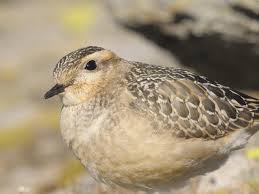
It breeds in the high plains of North America from extreme southeastern Alberta and southwestern Saskatchewan to northern New Mexicoand the Texas panhandle, as well as an isolated site in the Davis Mountains of West Texas. About 85 percent of the population winters in the San Joaquin and Imperial Valleys in California. Its winter range also extends along the U.S.-Mexican border, more extensively on the Mexican side. The Mountain Plover needs about 70 acres of territory for breeding, and about 25 acres for survival in non-breeding times.
Around late July, Mountain Plovers leave their breeding range for a period of post-breeding wandering around the southern Great Plains. Little is known about their movements at this time, although they are regularly seen around Walsh, Colorado and on sod farms in central New Mexico. By early November, most move southward and westward to their wintering grounds. Spring migration is apparently direct and non-stop.
Ecology and status[edit]
It feeds mostly on insects and other small arthropods. It often associates with livestock, which attract and stir up insects.
Mountain Plovers nest on bare ground in early spring (April in northern Colorado). The breeding territory must have bare round with short, sparse vegetation. Plovers usually select a breeding range that they share with bison and black tailed prairie dogs. These animals are grazers that keep vegetation short. Plovers like to nest among prairie dog colonies because the foraging and burrowing that these animals do expose even more bare soil which creates an ideal habitat for plover nest sites. It is believed that plovers like to nest on bare soil because they blend into the land hiding them from birds that may pray on them and the short vegetation allows them to easily detect predators on the ground. It is also believed it is easier for them to spot insects to eat.
A Mountain Plover nest has a survival rate that ranges from 26%-65%. This wide range may be due to the impact that varying climate has on nest survival. A nest made in a colder climate with less precipitation has a better chance of survival. These conditions are preferred because of the climate's effect on the eggs directly, changes in predatory behavior, or changes in vegetation that can affect the mortality rates of parents. Higher heat may expose eggs to heat stress;also, a wetter climate may factor in to predators having a more sensitive sense of smell, aiding the discovery of nests. Nest predators are the biggest cause of nest destruction. Because of this, it is a primary driving force of survival rate. Increase in soil moisture may the environment of bare grounds and short grass that prairie birds thrive in.
Their breeding season extends over the summer months and ends some time around late July or early August. During mating the male will set a territory and perform displays to attract a female. Females lay multiple clutches of eggs with three eggs to a clutch; the eggs are off-white with blackish spots. Egg size decreases as the breeding season goes on because of the high energy cost on the females. It has been found that eggs laid during a time of drought tend to be larger providing the incubating chick with more nourishment and so a greater chance at survival. Mountain plovers perform uniparental incubation by both sexes. Females leave their first clutch to be incubated and tended to by the male and then lay a second clutch, which she tends to herself. This type of incubation suits the mountain plover well and allows for a greater yield of chicks compared to similar species of birds in which both the male and female tend a single clutch together. Females can mate with several males and have several male tended nests in one breeding season. This would result in a greater reproductive success for the female but there is a high energy cost on the female laying so many eggs and so it is more common for a female to lay only two clutches. If the eggs survive various dangers, especially such predators as Coyotes, snakes, and Swift Foxes, they hatch in 28 to 31 days, and the hatchlings leave the nest within a few hours. In the next two or three days, the family usually moves one to two kilometers from the nest site to a good feeding area, often near a water tank for livestock.
The population has been estimated at between 5,000 and 10,000 adult birds, although those numbers have recently been revised to the range of 11,000 to 14,000, with a total population estimate of about 15,000 to 20,000. In March 2009, a multi-agency report, the first of its kind, issued by the Cornell University Lab of Ornithology in conjunction with federal agencies and other organizations, indicated that the Mountain Plover is one of the birds showing serious declines in population.[2] The population of mountain plovers is in decline because of cultivation, urbanization, and over-grazing of their living space.
Fritz Knopf has closely studied the mountain plover, and has tracked population declines. These downhill trends led to a 1999 proposal to list them as a Threatened species. On June 29, 2009 the U.S. Fish and Wildlife Service published a proposed rule to list the mountain plover as threatened under the Endangered Species Act.[3]